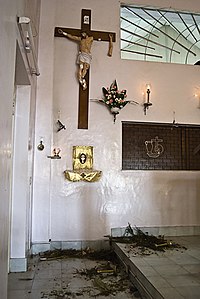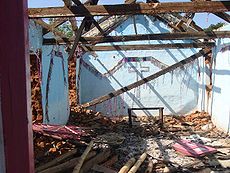User:Indology1985/sandbox
Conflicts and Controversies
[edit]Hindu–Christian conflict
[edit]
The arrival of European colonialists brought about large-scale missionary activity in coastal India and North-East India. Oppression of Hindus and the later sackings of Goa and Bombay-Bassein of those living in Portuguese India were the first known clashes.[1]

During the 1998 attacks on Christians in southeastern Gujarat, the Human Rights Watch reported that from 25 December 1988 to 3 January 1999, at least 20 prayer halls were damaged or burnt down and Christian institutions were attacked in the Dangs district, and its surrounding districts and at least 25 villages had reported incidents of burning and damages to prayer halls all over Gujarat.[2][3]
On 22 January 1999, an Australian missionary Graham Staines and his two sons were burnt to death by Dara Singh (Bajrang Dal) while sleeping in his station wagon at Manoharpur village in Keonjhar district in Odisha, India.,[4][5] In the annual human rights reports for 1999, the United States Department of State also criticized India for "increasing societal violence against Christians."[6] The report on anti-Christian violence listed over 90 incidents of anti-Christian violence, ranging from damage of religious property to violence against Christians pilgrims. The states of Rajasthan, Madhya Pradesh, Himachal Pradesh and Tamil Nadu passed laws placing restrictions on forced religious conversions as a result of communal tension between Christians and Hindus.[7] The legislation passed in Tamil Nadu was later repealed.[7]
In 2007, 19 churches were burned by Hindu right-wingers in Odisha following conflicts between Hindus and Christians regarding Christmas celebrations in the Kandhamal district.[8]
In 2008, there was again violence against Christians, particularly in the state of Orissa,[9] after the murder of Swami Lakshmanananda by Indian Maoists (communist insurgents), tensions flared between the two communities in 2008. Christians were blamed and attacked in Orissa with 38 killed and over 250 churches damaged while several thousands of Christians were displaced. Sitting BJP MLA Manoj Pradhan was sentenced to rigorous imprisonment for six years by a fast track court for a murder during the 2008 communal riots in Odisha's Kandhamal district.[10][11][12] The 2008 anti-Christian attacks in Orissa spilled over and escalated into the 2008 attacks on Christians in southern Karnataka state. The acts of violence include arson and vandalism of churches, conversion of Christians to Hinduism by threats (force) of physical violence, distribution of threatening literature, burning of Bibles, raping of nuns, murder of Christian priests, and destruction of Christian schools, colleges and cemeteries.[13][14][15]
Muslim–Christian conflict
[edit]
In spite of the fact that there have been relatively fewer conflicts between Muslims and Christians in India in comparison to those between Muslims and Hindus, or Muslims and Sikhs, the relationship between Muslims and Christians has also been occasionally turbulent. With the advent of European colonialism in India throughout the 16th, 17th and 18th centuries, Christians were systematically persecuted in a few Muslim-ruled kingdoms in India.
Among the anti-Christian acts committed were those of Tippu Sultan, the ruler of the Kingdom of Mysore against the Mangalorean Catholic community from Mangalore (South Canara) district along the southwestern coast of India. Tippu was widely reputed to be anti-Christian. The captivity of Mangalorean Catholics at Seringapatam, which began on 24 February 1784 and ended on 4 May 1799, remains the most disconsolate memory in their history.[16]
The Bakur Manuscript reports him as having said: "All Musalmans should unite together, considering the annihilation of infidels as a sacred duty, and labour to the utmost of their power, to accomplish that subject."[17] Soon after the Treaty of Mangalore in 1784, Tippu gained control of Canara.[18] He issued orders to seize the Christians in Canara, confiscate their estates,[19] and deport them to Seringapatam, the capital of his empire, through the Jamalabad fort route.[20] However, there were no priests among the captives. Together with Fr Miranda, all the 21 arrested priests were issued orders of expulsion to Goa, fined Rs 200,000, and threatened death by hanging if they ever returned.[17]
Tippu ordered the destruction of 27 Catholic churches, all intricately carved with statues depicting various saints. Among them were Nossa Senhora de Rosario Milagres at Mangalore, Fr Miranda's Seminary at Monte Mariano, Jesu Marie Jose at Omzoor, the Chapel at Bolar, the Church of Merces at Ullal, Imaculata Conceiciao at Mulki, San Jose at Perar, Nossa Senhora dos Remedios at Kirem, Sao Lawrence at Karkal, Rosario at Barkur, and Immaculata Conceciao at Baidnur.[17] All were razed to the ground, with the exception of the Church of Holy Cross at Hospet, owing to the friendly offices of the Chauta Raja of Moodbidri.[21]
Historian William Dalrymple states that during the Indian Rebellion of 1857, the Muslims sepoys were motivated primarily by resistance against a move (use of the Enfield Rifle-Musket) by the East India Company, which was perceived as an attempt to impose Christian law in Hindustan.[22] For instance, when Mughal Emperor Bahadur Shah Zafar met the sepoys on 11 May 1857, he was told: "We have joined hands to protect our religion and our faith." They later stood in Chandni Chowk, the main square, and asked the people gathered there, "Brothers, are you with those of the faith?"[22] Those British men and women who had previously converted to Islam such as the defectors, Sergeant-Major Gordon, and Abdullah Beg, a former Company soldier, were spared.[23] On the contrary, foreign Christians such as Revd Midgeley John Jennings, as well as Indian converts to Christianity such as one of Zafar's personal physicians, Dr. Chaman Lal, were killed outright.[23]
Dalrymple further points out that as late as 6 September, when calling the inhabitants of Delhi to rally against the upcoming British assault, Zafar issued a proclamation stating that this was a religious war being prosecuted on behalf of 'the faith', and that all Muslim and Hindu residents of the imperial city, or of the countryside were encouraged to stay true to their faith and creeds.[22] As further evidence, he observes that the Urdu sources of the pre and post-rebellion periods usually refer to the British not as angrez (the English), goras (whites) or firangis (foreigners), but as kafir (infidels) and nasrani (Christians).[22]
In modern times, Muslims in India who convert to Christianity are often subjected to harassment, intimidation, and attacks by Muslims.[24][25] In Jammu and Kashmir, the only Indian state with a Muslim majority, a Christian convert and missionary named Bashir Tantray was killed, allegedly by militant Islamists in 2006.[26] However, there are cases in which a Muslim will adopt crypto-Christianity, secretly declaring his/ her conversion. In effect, they are practising Christians, but are legally Muslims; thus the statistics of Indian Christians may not include all Muslim converts to Christianity.[citation needed]
- ^ Goa and Portugal: Their Cultural Links, p. 35, by Charles J. Borges, Helmut Feldmann, year = 1997
- ^ "Refworld | Politics by Other Means: Attacks Against Christians in India". Refworld. Retrieved 11 April 2020.
- ^ "Bearing the cross: Recent attacks against Christians worrisome". Hindustan Times. 15 March 2015. Retrieved 11 April 2020.
- ^ "Where's Dara Singh?". outlookindia.com. Retrieved 11 January 2018.
- ^ "Remembering Graham Staines, 18 Years After His Murder". The Quint. Retrieved 11 January 2018.
- ^ "US rights report slams India for anti-Christian violence". 27 February 1999. Archived from the original on 16 February 2008. Retrieved 17 December 2007.
- ^ a b Bareth, Narayan (23 February 2005). "State to bar religious conversion". BBC News.
- ^ "India: Stop Hindu-Christian Violence in Orissa". Human Rights Watch. 30 December 2007. Retrieved 2 November 2013.
- ^ "Anti-Christian Violence on the Rise in India". Human Rights Watch. 1 October 1999. Retrieved 2 November 2013.
- ^ "Violence in India Is Fueled by Religious and Economic Divide". The New York Times. TIANGIA, India. 3 September 2008.
- ^ "BJP MLA convicted in Kandhamal riots case". The Hindu. Chennai, India. 9 September 2010.
- ^ Akkara, Anto (15 August 2016). "Indian Supreme Court: State Response to Anti-Christian Mob Violence 'Inadequate'". Gleanings | ChristianityToday.com. Retrieved 5 December 2016.
- ^ Vinay Lal. "Anti-Christian Violence in India". Manas: India and Its Neighbors. UCLA College of Letters and Science.
- ^ "Anti-Christian Violence on the Rise in India". Human Rights Watch. 29 September 1999.
- ^ "Attacks on Christians across India". Human Rights Watch.
- ^ "Deportation and The Konkani Christian Captivity at Srirangapatna (1784 Feb. 24th Ash Wednesday)". Daijiworld Media Pvt Ltd Mangalore. Archived from the original on 10 May 2006. Retrieved 29 February 2008.
- ^ a b c Sarasvati's Children, Joe Lobo
- ^ Forrest 1887, pp. 314–316
- ^ The Gentleman's Magazine 1833, p. M1 388
- ^ "Christianity in Mangalore". Diocese of Mangalore. Archived from the original on 9 July 2010. Retrieved 30 July 2008.
- ^ John B. Monteiro. "Monti Fest Originated at Farangipet – 240 Years Ago!". Daijiworld Media Pvt Ltd Mangalore. Archived from the original on 5 February 2012. Retrieved 28 April 2009.
- ^ a b c d Dalrymple 2009, pp. 22–23
- ^ a b Dalrymple 2009, pp. 153
- ^ Gheddo, Piero (25 May 2012). "INDIA Indian Kashmir, "unknown arsonists" set fire to a Catholic church – Asia News". Asianews.it. Retrieved 4 November 2013.
- ^ Carvalho, Nirmala. "INDIA Indian Kashmir, two Christians arrested on false charges of forced conversions". asianews.it. Retrieved 11 July 2016.
- ^ Christian convert from Islam shot dead in Kashmir Archived 17 October 2007 at the Wayback Machine,SperoNews

